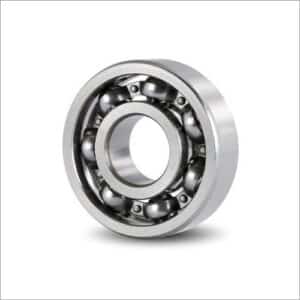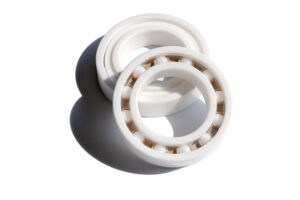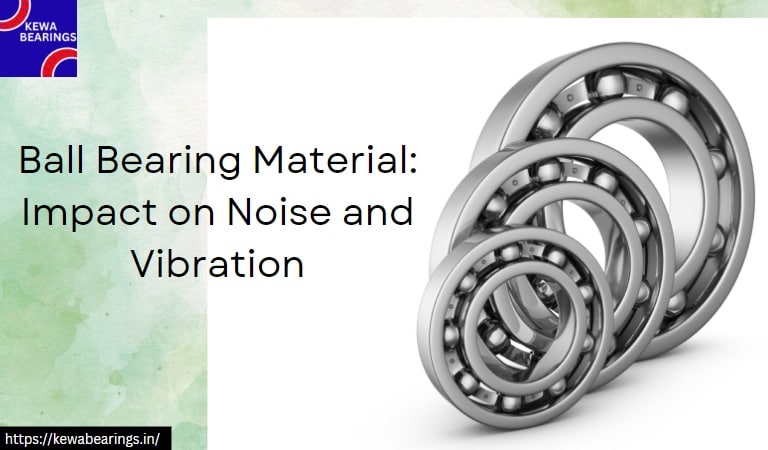Remember the time when the fan made this whirring noise? Or when your Activa started making noise? Well, we all hate the rumble of machinery no matter how big or small they are. While lubrication can be of great help, the best solution out there is using a great ball bearing material that reduces noise and vibration. This is because the material properties affect factors such as friction, heat generation, and natural frequencies, which can influence the overall noise and vibration characteristics of the bearing system. In this discussion, Kewa Bearings will explore how different materials can affect the noise and vibration levels of a ball bearing.
-
Steel
Steel is one of the most commonly used materials for ball bearings. The properties of steel, such as its hardness, durability, and high load-carrying capacity, make it suitable for a wide range of applications. However, steel ball bearings can generate noise and vibration due to several factors:

- Surface Finish: The surface finish of the steel balls and raceways can affect noise generation. Finer surface finishes reducing friction and noise levels.
- Lubrication: Proper lubrication is crucial for reducing friction and noise in steel bearings. Insufficient or improper lubrication can lead to increased noise and vibration.
- Ball Quality: The quality and precision of the steel balls can impact noise and vibration levels. Higher-quality balls with tighter tolerances can result in smoother operation and reduced noise.
- Cage Design: The cage, which holds the balls in position, can contribute to noise and vibration. Well-designed and properly lubricated cages help minimize noise generation.
-
Ceramic

Ceramic ball bearings are gaining popularity in various industries due to their unique applications. Ceramic materials, such as silicon nitride or zirconia, offer advantages over steel, including higher hardness, lower density, and superior resistance to heat and corrosion. These properties can contribute to reduced noise and vibration levels:
- Friction Reduction: Ceramic materials have lower friction coefficients compared to steel. This reduces the amount of energy converted into heat, resulting in lower vibration and noise levels.
- Higher Stiffness: Ceramic materials are stiffer than steel, which can contribute to reduced deformation and less vibration during operation.
- Natural Frequencies: Ceramic bearings typically have higher natural frequencies than steel bearings. This means that the resonance frequencies of the bearing system are higher, reducing the chances of vibration amplification and noise generation.
- Thermal Conductivity: Ceramic materials have better thermal conductivity than steel, which allows for improved heat dissipation. Lower heat generation reduces the likelihood of thermal expansion and associated noise.
It is important to note that while ceramic ball bearings offer potential benefits in terms of noise and vibration reduction, they may also have limitations. For example, ceramic ball bearings materials are more brittle than steel, making them more susceptible to damage from impacts or overloading.
-
Hybrid

Hybrid ball bearing materials combine ceramic balls with steel raceways and retainers (cages). This design aims to harness the advantages of both materials. Hybrid bearings can provide the following benefits related to noise and vibration:
- Reduced Friction: The ceramic balls reduce friction, contributing to lower noise and vibration levels.
- Damping Effect: The combination of different materials in hybrid bearings can result in improved damping properties, reducing vibration transmission.
- High-Speed Performance: Hybrid bearings, with their lower friction and reduced heat generation, can allow for higher rotational speeds, minimizing vibration issues at high speeds.
It is important to consider other factors, such as bearing design, lubrication, and proper installation, alongside the choice of ball bearing material, as they also play a significant role in noise and vibration control.
Henceforth, the selection of the material can influence noise and vibration levels in a bearing system. Stainless steel bearings, while widely used, can generate noise and vibration, which can be mitigated through factors such as surface finish, lubrication, ball quality, and cage design. Ceramic ball bearings offer advantages in terms of friction reduction, higher stiffness, and thermal conductivity, which contribute to lower noise and vibration levels.
Willing to fetch a quote? Reach out to Kewa Bearings now at https://kewabearings.in/contact-us/.

